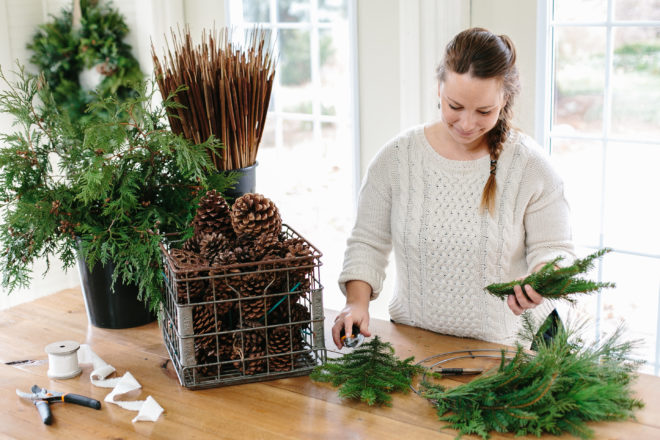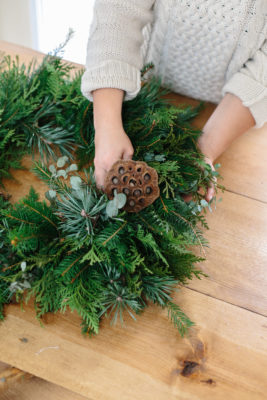Florist Jackie Ehlert Shares Wreath-making Process
- Share
- Tweet
- Pin
- Share

Bundles of cedar, white pine and blue spruce branches spill out from boxy containers spread out on the floor. Pine cones the size of small kittens overflow from a nearby metal crate. In the corner, an array of foraged items – mini cattails, seeded eucalyptus, lotus pods and ornamental grasses – stand at the ready. And the smell? Quintessential Christmas.
A few days later, a collection of locals and visitors gather at Blossoms Flower House to transform these random bits of Mother Nature into one-of-a-kind wreaths with the help of Blossoms’ owner and florist Jackie Ehlert.
Ehlert has owned and operated the flower studio on Sister Bay’s south end since 2015. What began as a flower shop and retail space has, this year, transformed into a floral studio designed for arranging flowers and hosting workshops. She has taught hundreds of people from near and far the delicate art of floral displays.
This holiday season was no exception. Ehlert opened Blossoms Flower House to the public for three wreath workshops in late November and early December, where she witnessed the creativity that comes alive with a little direction.
Though her public workshops for the season are over, Ehlert graciously shared with us her step-by-step process of turning locally sourced greenery into a festive display fit for your holiday trimmings.
Forage for Supplies
Greenery can be gathered up to three weeks before building your wreath, with the exception of blue spruce (it dries quickly, so harvest within a day of using). Head out to the woods, or your backyard, with pruning shears and a bucket, and see what catches your eye. Ehlert is partial to cedar, white pine, Norwegian pine and blue spruce.
“Three varieties is a really nice combination in the wreath,” she said. “It doesn’t get too busy but it makes everything else pop and brings a different dimension with the different shades.”
Branches should be cut to approximately 24 inches. A bucketful of greenery should suffice for a moderately sized wreath (in her workshops, Ehlert supplies 14-inch metal wreath forms) and a collection of other natural items – ornamental grasses and pinecones, for example – can also be collected.
If you aren’t creating the wreath immediately after foraging, leave the bucketful of cut branches outside in the cold (no water needed) so they remain dormant and fresh.
Building A Wreath
The basic tools of the trade are a wreath form (14-inch works well for a front door), wire clippers and paddle wire (Ehlert uses 24-gauge wire for her creations).
Bring your evergreens to your workspace and begin trimming branches into six-inch pieces, paying special attention to branches with special features, like berries or miniature pinecones. Make piles of each type of greenery and then begin building small “bundles” (using 8-10 pieces) in your hands.
“Then we wire them on the wreath forms,” Ehlert said.
Ehlert attaches the paddle wire to the wreath form and begins wiring one bundle at a time to the form.
“Each bundle gets three to four wraps with the paddle wire then you make another bundle and then you wrap it another three to four times until you’re done,” Ehlert said.
To secure everything in place, Ehlert cuts a 12-inch piece of wire and weaves it through the wreath rings, twisting it onto the form to hold it in place. Further adornments may be added before hanging the wreath in your home or on the door. For those who keep it outside in the cold, expect it to stay up through March.
“Once the wreaths are outside solidly they last quite a long time,” she said. “Some people feel like adding a preservative to them. I’ve never found the need to and if you don’t need to add the chemical, I don’t.”
One more thing – the inevitable, sticky sap of gathering evergreens and building a wreath? Ehlert’s time in the business has taught her a tried-and-true method for cleanup.
“Some sort of fat needs to cut the sap,” she said. “Sometimes I use coconut oil, even a cooking spray – if you spray that on your hands and then use soap and water, it comes off like a charm, everytime.”
For more information, visit blossomsflowerhouse.com.






